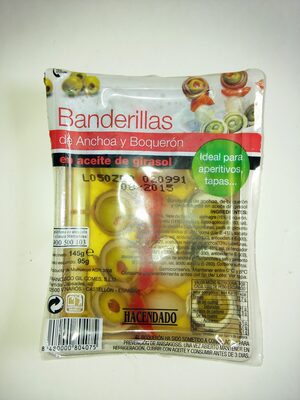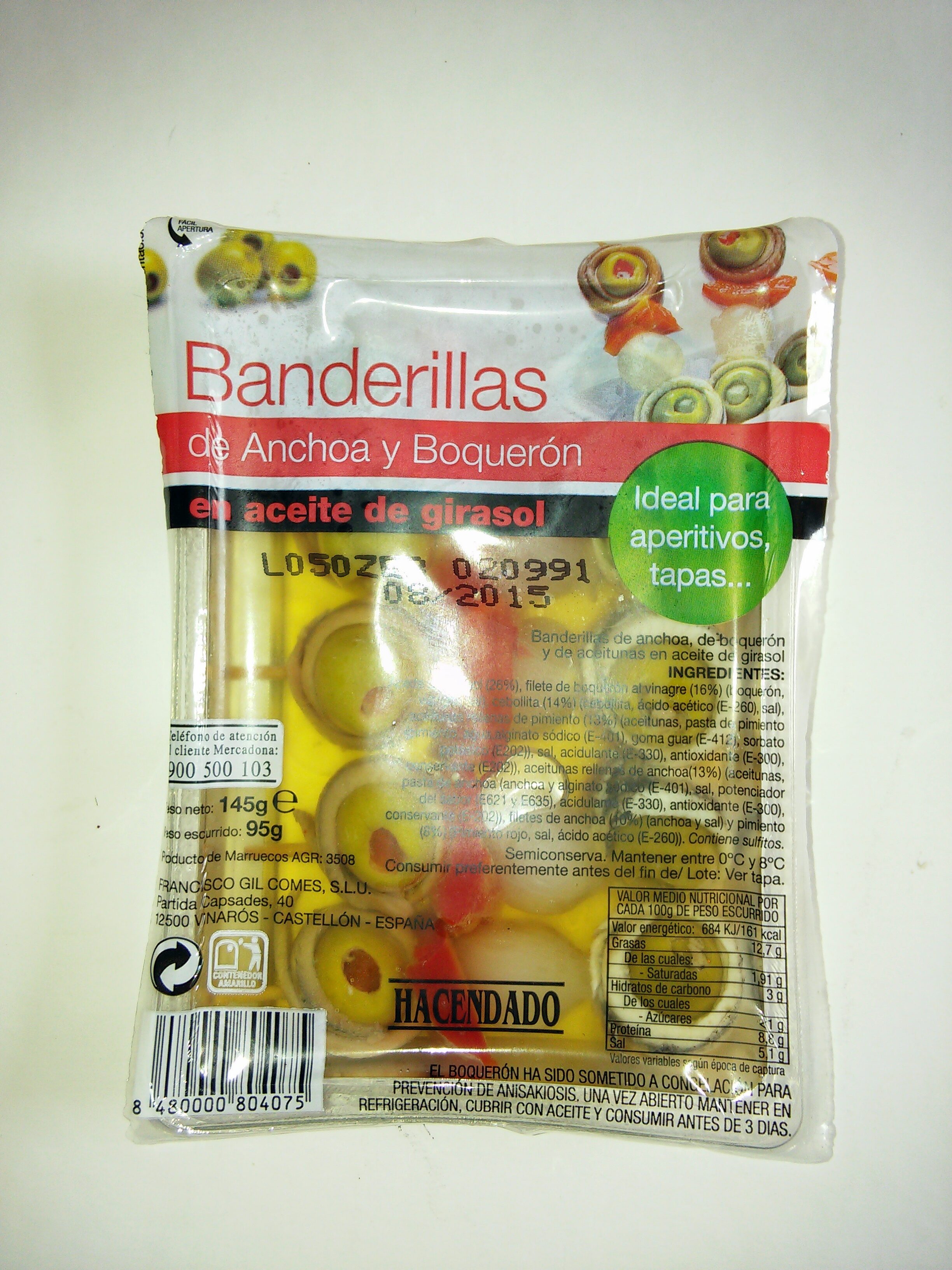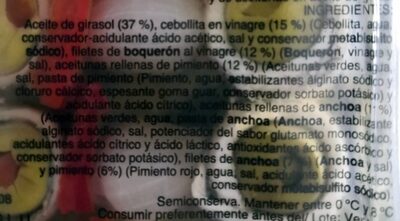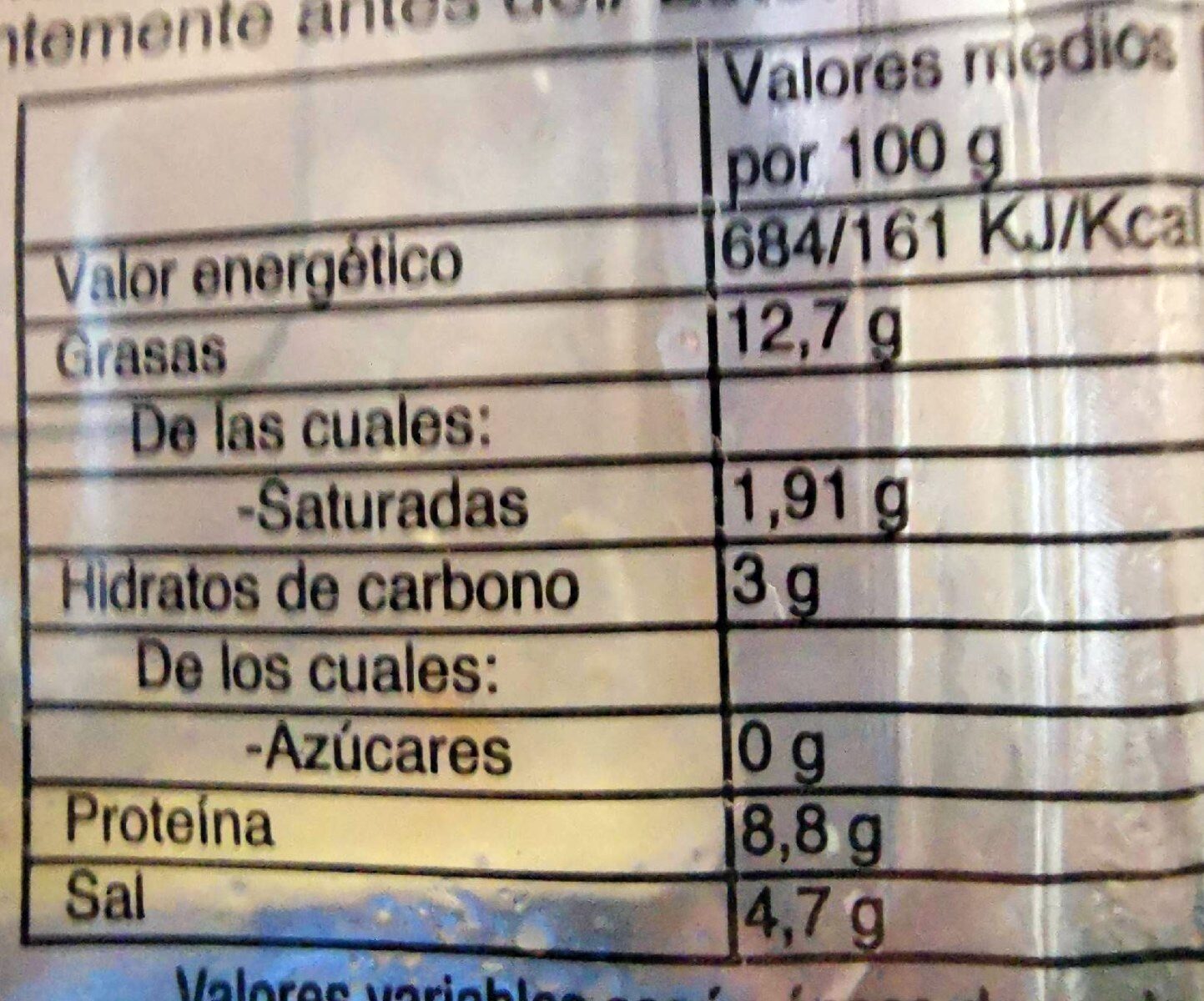Ajuda'ns a fer que la transparència alimentària sigui la norma!
Com a organització sense ànim de lucre, depenem de les vostres donacions per continuar informant els consumidors de tot el món sobre tot allò què mengen.
La revolució alimentària comença amb tu!
Banderillas de anchoa y boquerón en aceite de girasol - Hacendado - 145 g
Banderillas de anchoa y boquerón en aceite de girasol - Hacendado - 145 g
Aquesta pàgina del producte no està completa. Podeu ajudar a completar-la editant-la i afegint-hi més dades a partir de les fotos ja disponibles, o fent-ne més amb l'aplicació de androide o iPhone / iPad. Gràcies!
×
Codi de barres: 8480000804075 (EAN / EAN-13)
Nom comú: Banderillas de anchoa, de boquerón y de aceitunas en aceite de girasol
Quantitat: 145 g
Empaquetament: es:Bandeja de plastico, es:Green dot
Marques: Hacendado
Categories: Aliments i begudes amb base vegetal, Aliments amb base vegetal, Marisc, en:Fishes and their products, Peix, Conserves, Conserves vegetals, en:Plant-based mixed pickles, en:Banderillas
Etiquetes, certificacions, premis:
Punt verd, Amb oli de gira-sol
Origen dels ingredients: Marroc
Botigues: Mercadona
Països on es va vendre: Espanya
Matching with your preferences
Salut
Ingredients
-
57 ingredients
: Aceite de girasol 37%, cebollita en vinagre 15% (cebollita, agua, conservador-acidulante (ácido acético), sal, conservador (metabisulfito sódico)), filetes de boquerón al vinagre 12% (boquerón, vinagre, sal), aceitunas rellenas de pimiento 12% (aceitunas verdes, agua, sal, pasta de pimiento (pimiento, agua, estabilizantes (alginato sódico, cloruro cálcico), espesante (goma guar), conservador (sorbato potásico)), acidulante (ácido citrico)), aceitunas rellenas de anchoa 11% (aceitunas verdes, agua, pasta de anchoa (anchoa, estabilizante (alginato sódico), sal, potenciador del sabor (glutamato monosódico), acidulantes (ácido citrico, ácido láctico), antioxidantes (ácido ascórbico), conservador (sorbato potásico)), filetes de anchoa 7% (anchoa, sal), pimiento 6% (pimiento rojo, agua, sal, acidulante (ácido acético), conservador (metabisulfito sódico)).Al·lèrgens: en:Fish, en:Sulphur dioxide and sulphites, es:anchoa, es:boqueron, es:metabisulfito-sodico
Processament d'aliments
-
Aliments ultra processats
Elements que indiquen que el producte està al grup 4 - Aliments i begudes ultraprocessats:
- Additiu: E401 - Alginat de sodi
- Additiu: E412 - Goma de guar
- Additiu: E621 - Glutamat de monosodi
- Ingredient: Potenciador del gust
- Ingredient: Espessidor
Els productes alimentaris es classifiquen en 4 grups segons el seu grau de processament:
- Aliments no processats o mínimament processats
- Ingredients culinaris processats
- Aliments processats
- Aliments ultra processats
La determinació del grup es fa en funció de la categoria del producte i dels ingredients que conté.
Additius
-
E202 - Sorbat de potassi
Potassium sorbate: Potassium sorbate is the potassium salt of sorbic acid, chemical formula CH3CH=CH−CH=CH−CO2K. It is a white salt that is very soluble in water -58.2% at 20 °C-. It is primarily used as a food preservative -E number 202-. Potassium sorbate is effective in a variety of applications including food, wine, and personal-care products. While sorbic acid is naturally occurring in some berries, virtually all of the world's production of sorbic acid, from which potassium sorbate is derived, is manufactured synthetically.Origen: Wikipedia (Anglès)
-
E223 - Metabisulfit de sodi
Sodium metabisulfite: Sodium metabisulfite or sodium pyrosulfite -IUPAC spelling; Br. E. sodium metabisulphite or sodium pyrosulphite- is an inorganic compound of chemical formula Na2S2O5. The substance is sometimes referred to as disodium metabisulfite. It is used as a disinfectant, antioxidant, and preservative agent.Origen: Wikipedia (Anglès)
-
E260 - Àcid acètic
Acetic acid: Acetic acid , systematically named ethanoic acid , is a colorless liquid organic compound with the chemical formula CH3COOH -also written as CH3CO2H or C2H4O2-. When undiluted, it is sometimes called glacial acetic acid. Vinegar is no less than 4% acetic acid by volume, making acetic acid the main component of vinegar apart from water. Acetic acid has a distinctive sour taste and pungent smell. In addition to household vinegar, it is mainly produced as a precursor to polyvinyl acetate and cellulose acetate. It is classified as a weak acid since it only partially dissociates in solution, but concentrated acetic acid is corrosive and can attack the skin. Acetic acid is the second simplest carboxylic acid -after formic acid-. It consists of a methyl group attached to a carboxyl group. It is an important chemical reagent and industrial chemical, used primarily in the production of cellulose acetate for photographic film, polyvinyl acetate for wood glue, and synthetic fibres and fabrics. In households, diluted acetic acid is often used in descaling agents. In the food industry, acetic acid is controlled by the food additive code E260 as an acidity regulator and as a condiment. In biochemistry, the acetyl group, derived from acetic acid, is fundamental to all forms of life. When bound to coenzyme A, it is central to the metabolism of carbohydrates and fats. The global demand for acetic acid is about 6.5 million metric tons per year -Mt/a-, of which approximately 1.5 Mt/a is met by recycling; the remainder is manufactured from methanol. Vinegar is mostly dilute acetic acid, often produced by fermentation and subsequent oxidation of ethanol.Origen: Wikipedia (Anglès)
-
E270 - Àcid làctic
Lactic acid: Lactic acid is an organic compound with the formula CH3CH-OH-COOH. In its solid state, it is white and water-soluble. In its liquid state, it is colorless. It is produced both naturally and synthetically. With a hydroxyl group adjacent to the carboxyl group, lactic acid is classified as an alpha-hydroxy acid -AHA-. In the form of its conjugate base called lactate, it plays a role in several biochemical processes. In solution, it can ionize a proton from the carboxyl group, producing the lactate ion CH3CH-OH-CO−2. Compared to acetic acid, its pKa is 1 unit less, meaning lactic acid deprotonates ten times more easily than acetic acid does. This higher acidity is the consequence of the intramolecular hydrogen bonding between the α-hydroxyl and the carboxylate group. Lactic acid is chiral, consisting of two optical isomers. One is known as L--+--lactic acid or -S--lactic acid and the other, its mirror image, is D--−--lactic acid or -R--lactic acid. A mixture of the two in equal amounts is called DL-lactic acid, or racemic lactic acid. Lactic acid is hygroscopic. DL-lactic acid is miscible with water and with ethanol above its melting point which is around 17 or 18 °C. D-lactic acid and L-lactic acid have a higher melting point. In animals, L-lactate is constantly produced from pyruvate via the enzyme lactate dehydrogenase -LDH- in a process of fermentation during normal metabolism and exercise. It does not increase in concentration until the rate of lactate production exceeds the rate of lactate removal, which is governed by a number of factors, including monocarboxylate transporters, concentration and isoform of LDH, and oxidative capacity of tissues. The concentration of blood lactate is usually 1–2 mM at rest, but can rise to over 20 mM during intense exertion and as high as 25 mM afterward. In addition to other biological roles, L-lactic acid is the primary endogenous agonist of hydroxycarboxylic acid receptor 1 -HCA1-, which is a Gi/o-coupled G protein-coupled receptor -GPCR-.In industry, lactic acid fermentation is performed by lactic acid bacteria, which convert simple carbohydrates such as glucose, sucrose, or galactose to lactic acid. These bacteria can also grow in the mouth; the acid they produce is responsible for the tooth decay known as caries. In medicine, lactate is one of the main components of lactated Ringer's solution and Hartmann's solution. These intravenous fluids consist of sodium and potassium cations along with lactate and chloride anions in solution with distilled water, generally in concentrations isotonic with human blood. It is most commonly used for fluid resuscitation after blood loss due to trauma, surgery, or burns.Origen: Wikipedia (Anglès)
-
E330 - Acid citric
Citric acid: Citric acid is a weak organic acid that has the chemical formula C6H8O7. It occurs naturally in citrus fruits. In biochemistry, it is an intermediate in the citric acid cycle, which occurs in the metabolism of all aerobic organisms. More than a million tons of citric acid are manufactured every year. It is used widely as an acidifier, as a flavoring and chelating agent.A citrate is a derivative of citric acid; that is, the salts, esters, and the polyatomic anion found in solution. An example of the former, a salt is trisodium citrate; an ester is triethyl citrate. When part of a salt, the formula of the citrate ion is written as C6H5O3−7 or C3H5O-COO-3−3.Origen: Wikipedia (Anglès)
-
E412 - Goma de guar
Guar gum: Guar gum, also called guaran, is a galactomannan polysaccharide extracted from guar beans that has thickening and stabilizing properties useful in the food, feed and industrial applications. The guar seeds are mechanically dehusked, hydrated, milled and screened according to application. It is typically produced as a free-flowing, off-white powder.Origen: Wikipedia (Anglès)
-
E621 - Glutamat de monosodi
Monosodium glutamate: Monosodium glutamate -MSG, also known as sodium glutamate- is the sodium salt of glutamic acid, one of the most abundant naturally occurring non-essential amino acids. Glutamic acid is found naturally in tomatoes, grapes, cheese, mushrooms and other foods.MSG is used in the food industry as a flavor enhancer with an umami taste that intensifies the meaty, savory flavor of food, as naturally occurring glutamate does in foods such as stews and meat soups. It was first prepared in 1908 by Japanese biochemist Kikunae Ikeda, who was trying to isolate and duplicate the savory taste of kombu, an edible seaweed used as a base for many Japanese soups. MSG as a flavor enhancer balances, blends, and rounds the perception of other tastes.The U.S. Food and Drug Administration has given MSG its generally recognized as safe -GRAS- designation. A popular belief is that large doses of MSG can cause headaches and other feelings of discomfort, known as "Chinese restaurant syndrome," but double-blind tests fail to find evidence of such a reaction. The European Union classifies it as a food additive permitted in certain foods and subject to quantitative limits. MSG has the HS code 29224220 and the E number E621.Origen: Wikipedia (Anglès)
Anàlisi dels ingredients
-
Es desconeix si conté oli de palma
Ingredients no reconeguts: es:conservador-acidulante, es:filetes-de-boqueron-al-vinagre, es:aceitunas-rellenas-de-pimiento, es:pasta-de-pimiento, es:aceitunas-rellenas-de-anchoaAlguns ingredients no s'han pogut reconèixer.
Necessitem la teva ajuda!
Podeu ajudar-nos a reconèixer més ingredients i analitzar millor la llista d'ingredients d'aquest producte i d'altres mitjançant:
- Editeu aquesta pàgina de producte per corregir les faltes d’ortografia de la llista d’ingredients i/o per eliminar els ingredients d’altres idiomes i frases que no estiguin relacionades amb els ingredients.
- Afegiu entrades, sinònims o traduccions noves a les nostres llistes multilingües d’ingredients, mètodes de processament d’ingredients i etiquetes.
Uniu-vos al canal #ingredients del nostre espai de discussió a Slack i/o apreneu sobre l'anàlisi dels ingredients en la nostra wiki, si voleu ajudar. Gràcies!
-
No és vegà
Ingredients no vegans: Seitó, Pasta d'anxova, Engràulid, en:Anchovy filets, EngràulidAlguns ingredients no s'han pogut reconèixer.
Necessitem la teva ajuda!
Podeu ajudar-nos a reconèixer més ingredients i analitzar millor la llista d'ingredients d'aquest producte i d'altres mitjançant:
- Editeu aquesta pàgina de producte per corregir les faltes d’ortografia de la llista d’ingredients i/o per eliminar els ingredients d’altres idiomes i frases que no estiguin relacionades amb els ingredients.
- Afegiu entrades, sinònims o traduccions noves a les nostres llistes multilingües d’ingredients, mètodes de processament d’ingredients i etiquetes.
Uniu-vos al canal #ingredients del nostre espai de discussió a Slack i/o apreneu sobre l'anàlisi dels ingredients en la nostra wiki, si voleu ajudar. Gràcies!
-
No és vegetarià
Ingredients no vegetarians: Seitó, Pasta d'anxova, Engràulid, en:Anchovy filets, EngràulidAlguns ingredients no s'han pogut reconèixer.
Necessitem la teva ajuda!
Podeu ajudar-nos a reconèixer més ingredients i analitzar millor la llista d'ingredients d'aquest producte i d'altres mitjançant:
- Editeu aquesta pàgina de producte per corregir les faltes d’ortografia de la llista d’ingredients i/o per eliminar els ingredients d’altres idiomes i frases que no estiguin relacionades amb els ingredients.
- Afegiu entrades, sinònims o traduccions noves a les nostres llistes multilingües d’ingredients, mètodes de processament d’ingredients i etiquetes.
Uniu-vos al canal #ingredients del nostre espai de discussió a Slack i/o apreneu sobre l'anàlisi dels ingredients en la nostra wiki, si voleu ajudar. Gràcies!
-
Detalls de l'anàlisi dels ingredients
Necessitem la teva ajuda!
Alguns ingredients no s'han pogut reconèixer.
Necessitem la teva ajuda!
Podeu ajudar-nos a reconèixer més ingredients i analitzar millor la llista d'ingredients d'aquest producte i d'altres mitjançant:
- Editeu aquesta pàgina de producte per corregir les faltes d’ortografia de la llista d’ingredients i/o per eliminar els ingredients d’altres idiomes i frases que no estiguin relacionades amb els ingredients.
- Afegiu entrades, sinònims o traduccions noves a les nostres llistes multilingües d’ingredients, mètodes de processament d’ingredients i etiquetes.
Uniu-vos al canal #ingredients del nostre espai de discussió a Slack i/o apreneu sobre l'anàlisi dels ingredients en la nostra wiki, si voleu ajudar. Gràcies!
: Aceite de girasol 37%, cebollita 15% (cebollita, agua, conservador-acidulante (ácido acético), sal, conservador (_metabisulfito sódico_)), filetes de _boquerón_ al vinagre 12% (_boquerón_, vinagre, sal), aceitunas rellenas de pimiento 12%, aceitunas verdes, agua, sal, pasta de pimiento (pimiento, agua, estabilizantes (alginato sódico, cloruro cálcico), espesante (goma guar), conservador (sorbato potásico)), acidulante (ácido citrico), aceitunas rellenas de anchoa 11%, aceitunas verdes, agua, pasta de _anchoa_ (_anchoa_, estabilizante (alginato sódico), sal, potenciador del sabor (glutamato monosódico), acidulantes (ácido citrico, ácido láctico), antioxidantes (ácido ascórbico), conservador (sorbato potásico)), filetes de _anchoa_ 7% (_anchoa_, sal), pimiento 6% (pimiento rojo, agua, sal, acidulante (ácido acético), conservador (_metabisulfito sódico_))- Aceite de girasol -> en:sunflower-oil - vegan: yes - vegetarian: yes - from_palm_oil: no - ciqual_food_code: 17440 - percent: 37
- cebollita -> en:small-white-onions - vegan: yes - vegetarian: yes - ciqual_food_code: 20034 - percent: 15
- cebollita -> en:small-white-onions - vegan: yes - vegetarian: yes - ciqual_food_code: 20034
- agua -> en:water - vegan: yes - vegetarian: yes - ciqual_food_code: 18066
- conservador-acidulante -> es:conservador-acidulante
- ácido acético -> en:e260 - vegan: yes - vegetarian: yes
- sal -> en:salt - vegan: yes - vegetarian: yes - ciqual_food_code: 11058
- conservador -> en:preservative
- _metabisulfito sódico_ -> en:e223 - vegan: yes - vegetarian: yes
- filetes de _boquerón_ al vinagre -> es:filetes-de-boqueron-al-vinagre - percent: 12
- _boquerón_ -> en:european-anchovy - vegan: no - vegetarian: no - ciqual_food_code: 26079
- vinagre -> en:vinegar - vegan: yes - vegetarian: yes - ciqual_food_code: 11018
- sal -> en:salt - vegan: yes - vegetarian: yes - ciqual_food_code: 11058
- aceitunas rellenas de pimiento -> es:aceitunas-rellenas-de-pimiento - percent: 12
- aceitunas verdes -> en:green-olive - vegan: yes - vegetarian: yes - ciqual_food_code: 13033
- agua -> en:water - vegan: yes - vegetarian: yes - ciqual_food_code: 18066
- sal -> en:salt - vegan: yes - vegetarian: yes - ciqual_food_code: 11058
- pasta de pimiento -> es:pasta-de-pimiento
- pimiento -> en:bell-pepper - vegan: yes - vegetarian: yes - ciqual_food_code: 20041
- agua -> en:water - vegan: yes - vegetarian: yes - ciqual_food_code: 18066
- estabilizantes -> en:stabiliser
- alginato sódico -> en:e401 - vegan: yes - vegetarian: yes
- cloruro cálcico -> en:e509 - vegan: yes - vegetarian: yes
- espesante -> en:thickener
- goma guar -> en:e412 - vegan: yes - vegetarian: yes
- conservador -> en:preservative
- sorbato potásico -> en:e202 - vegan: yes - vegetarian: yes
- acidulante -> en:acid
- ácido citrico -> en:e330 - vegan: yes - vegetarian: yes
- aceitunas rellenas de anchoa -> es:aceitunas-rellenas-de-anchoa - percent: 11
- aceitunas verdes -> en:green-olive - vegan: yes - vegetarian: yes - ciqual_food_code: 13033
- agua -> en:water - vegan: yes - vegetarian: yes - ciqual_food_code: 18066
- pasta de _anchoa_ -> en:anchovy-paste - vegan: no - vegetarian: no - ciqual_food_code: 26079
- _anchoa_ -> en:anchovy - vegan: no - vegetarian: no - ciqual_food_code: 26079
- estabilizante -> en:stabiliser
- alginato sódico -> en:e401 - vegan: yes - vegetarian: yes
- sal -> en:salt - vegan: yes - vegetarian: yes - ciqual_food_code: 11058
- potenciador del sabor -> en:flavour-enhancer
- glutamato monosódico -> en:e621 - vegan: yes - vegetarian: yes
- acidulantes -> en:acid
- ácido citrico -> en:e330 - vegan: yes - vegetarian: yes
- ácido láctico -> en:e270 - vegan: yes - vegetarian: yes
- antioxidantes -> en:antioxidant
- ácido ascórbico -> en:e300 - vegan: yes - vegetarian: yes
- conservador -> en:preservative
- sorbato potásico -> en:e202 - vegan: yes - vegetarian: yes
- filetes de _anchoa_ -> en:anchovy-filets - vegan: no - vegetarian: no - ciqual_food_code: 26079 - percent: 7
- _anchoa_ -> en:anchovy - vegan: no - vegetarian: no - ciqual_food_code: 26079
- sal -> en:salt - vegan: yes - vegetarian: yes - ciqual_food_code: 11058
- pimiento -> en:bell-pepper - vegan: yes - vegetarian: yes - ciqual_food_code: 20041 - percent: 6
- pimiento rojo -> en:red-bell-pepper - vegan: yes - vegetarian: yes - ciqual_food_code: 20087
- agua -> en:water - vegan: yes - vegetarian: yes - ciqual_food_code: 18066
- sal -> en:salt - vegan: yes - vegetarian: yes - ciqual_food_code: 11058
- acidulante -> en:acid
- ácido acético -> en:e260 - vegan: yes - vegetarian: yes
- conservador -> en:preservative
- _metabisulfito sódico_ -> en:e223 - vegan: yes - vegetarian: yes
Nutrició
-
Poca qualitat nutricional
⚠ ️Atenció: la quantitat de fibra no s'especifica, no es tindrà en compte la seva possible contribució positiva en la qualificació.⚠ ️Atenció: la quantitat de fruita, verdura i fruits secs no s'especifica a l'etiqueta, s'ha fet una estimació a partir de la llista d'ingredients: 33Aquest producte no es considera una beguda per al càlcul de la Nutri-Score.
Punts positius: 0
- Proteïnes: 5 / 5 (valor: 8.8, valor arrodonit: 8.8)
- Fibra: 0 / 5 (valor: 0, valor arrodonit: 0)
- Fruites, verdures, fruits secs i olis de colza/nou/oliva: 0 / 5 (valor: 33.75, valor arrodonit: 33.8)
Punts negatius: 13
- Energia: 2 / 10 (valor: 684, valor arrodonit: 684)
- Sucres: 0 / 10 (valor: 0, valor arrodonit: 0)
- Greixos saturats: 1 / 10 (valor: 1.91, valor arrodonit: 1.9)
- Sodi: 10 / 10 (valor: 1880, valor arrodonit: 1880)
Els punts per proteïnes no es compten perquè els punts negatius són més o iguals a 11.
Puntuació nutricional: (13 - 0)
Nutri-Score:
-
Nivells de nutrients
-
Greix en Quantitat moderada (12.7%)
Què us cal saber- Un alt consum de greixos, especialment de greixos saturats, pot augmentar el colesterol, que augmenta el risc de patir malalties del cor.
Recomanació: Reduïu el consum de greixos i greixos saturats- Trieu productes amb menys greixos i greixos saturats.
-
Àcid gras saturat en Quantitat moderada (1.91%)
Què us cal saber- Un alt consum de greixos, especialment de greixos saturats, pot augmentar el colesterol, que augmenta el risc de patir malalties del cor.
Recomanació: Reduïu el consum de greixos i greixos saturats- Trieu productes amb menys greixos i greixos saturats.
-
Sucre en baixa quantitat (0%)
Què us cal saber- Un alt consum de sucre pot provocar augment de pes i càries dental. També augmenta el risc de patir diabetis tipus 2 i malalties cardiovasculars.
Recomanació: Limitau el consum de sucre i de begudes ensucrades- Les begudes ensucrades (com ara refrescos, begudes de fruites i sucs i nèctars de fruites) s'han de limitar tant com sigui possible (no més d'1 got al dia).
- Triau productes amb menor contingut de sucre i reduïu el consum de productes amb sucres afegits.
-
Sal comuna en alta quantitat (4.7%)
Què us cal saber- Un alt consum de sal (o sodi) pot provocar un augment de la pressió arterial, que pot augmentar el risc de patir malalties del cor i ictus.
- Moltes persones que tenen hipertensió no ho saben, ja que sovint no en tenen símptomes.
- La majoria de la gent consumeix massa sal (de 9 a 12 grams de mitjana al dia), al voltant del doble del nivell màxim d'ingesta recomanat.
Recomanació: Limitau la ingesta de sal i d'aliments rics en sal- Reduïu la sal que emprau quan cuinau, i no afegiu sal a taula.
- Limiteu el consum d'aperitius salats i trieu productes amb menor contingut de sal.
-
-
Informació nutricional
Informació nutricional Com es ven
per 100 g/100 mlComparat amb: en:Banderillas Energia 684 kj
(161 kcal)+180% Greix 12,7 g +257% Àcid gras saturat 1,91 g +158% Hidrats de carboni 3 g +59% Sucre 0 g -100% Fiber ? Proteïna 8,8 g +415% Sal comuna 4,7 g +63% Fruits‚ vegetables‚ nuts and rapeseed‚ walnut and olive oils (estimate from ingredients list analysis) 33,75 %
Entorn
-
Puntuació ecològica no calculada - Impacte ambiental desconegut
No hem pogut calcular l'Eco-Score d'aquest producte perquè li falten algunes dades, podríeu ajudar-nos a completar-lo?Podries afegir una categoria del producte més precisa perquè puguem calcular l'Eco-Score? Afegir una categoria
Empaquetament
-
Embalatge d'impacte mitjà
-
Peces d'embalatge
(Plàstic)
-
Materials d'embalatge
Material % Pes de l'embalatge Pes de l'embalatge per 100 g de producte Plàstic
-
Transport
-
Orígens dels ingredients
Orígens dels ingredients amb impacte mitjà
Origen del producte i / o dels seus ingredients % d'ingredients Impacte Marroc 100 %Mitjà
Report a problem
-
Incomplete or incorrect information?
Category, labels, ingredients, allergens, nutritional information, photos etc.
If the information does not match the information on the packaging, please complete or correct it. Open Food Facts is a collaborative database, and every contribution is useful for all.
Fonts de dades
Producte afegit per malikele
Última modificació de la pàgina del producte per packbot.
La pàgina del producte, també editada per acuario, alia, kiliweb, musarana, org-app-elcoco, yuka.ZjZrZ0NmZ3Z1T0FEdVBNZjR6TEp3ZlZINEoyRUFEN3BBck1MSWc9PQ.











